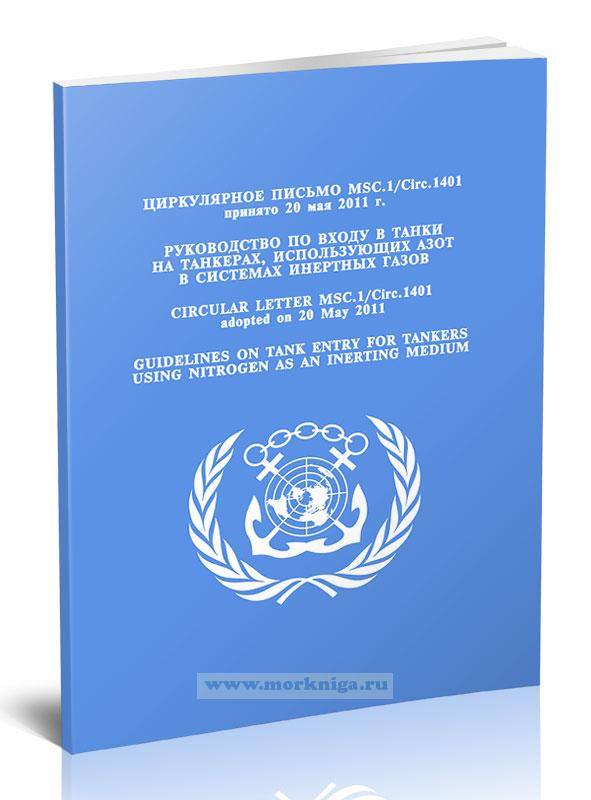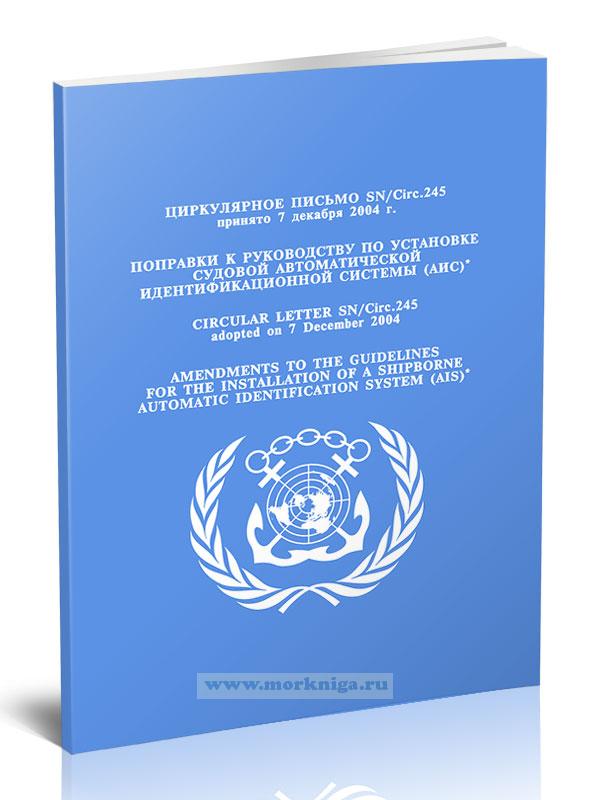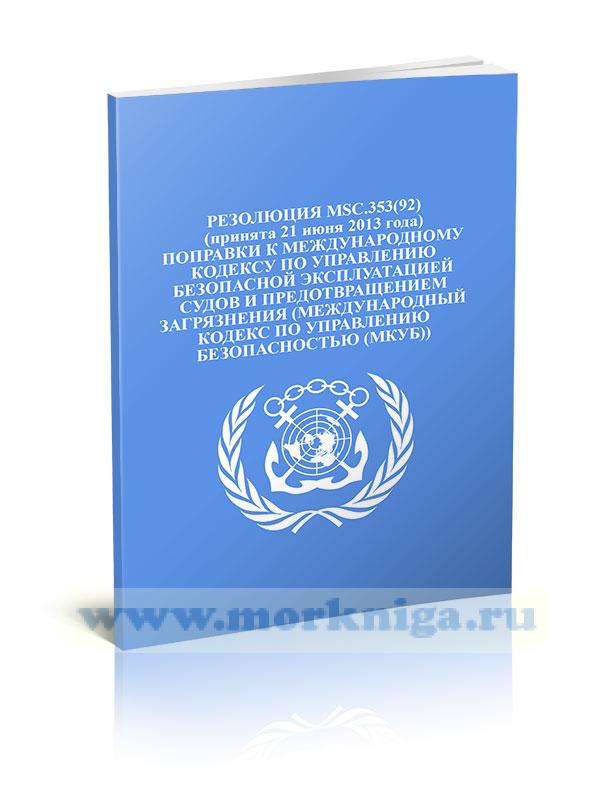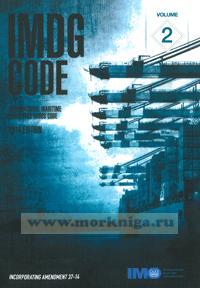IMDG Code. International Maritime Dangerous Goods Code. 2014 edition. Volume 1 and Volume 2. Incorporating amendment 37-14
-
 Циркулярное письмо MSC.1/Circ.1401 Руководство по входу в танки на танкерах, использующих азот в системах инертных газов
Циркулярное письмо MSC.1/Circ.1401 Руководство по входу в танки на танкерах, использующих азот в системах инертных газов
-
 Циркулярное письмо SN/Circ.245 Поправки к руководству по установке судовой автоматической идентификационной системы (АИС)
Циркулярное письмо SN/Circ.245 Поправки к руководству по установке судовой автоматической идентификационной системы (АИС)
-
 Резолюция MSC.353(92) Поправки к Международному кодексу по управлению безопасносной эксплуатацией судов и предотвращением загрязнения (МКУ
Резолюция MSC.353(92) Поправки к Международному кодексу по управлению безопасносной эксплуатацией судов и предотвращением загрязнения (МКУ
Документ потерял актуальность с выходом
IMDG Code. International Maritime Dangerous Goods Code. 2016 edition. Volume 1 and Volume 2
This publication has been prepared from official documents of IMO, and every effort has been made to eliminate errors and reproduce the original text(s) faithfully.
Readers should be aware that, in case of inconsistency, the official IMO text will prevail.
См. также IMDG Code. International Maritime Dangerous Goods Code. 2014 edition. Supplement
Международный кодекс морской перевозки опасных грузов. МКМПОГ. IMDG Code. В 2-х томах. Включающий поправки 36-12
Руководство по оказанию первой медицинской помощи при несчастных случаях, связанных с опасными грузами (РПМП). Добавление к Кодексу ММОГ. Medical First Aid Guide for Use in Accidents Involving Dangerous Goods(MFAG). IMDG Code Supplement.
Содержание:
Содержание
Volume 1
Contents Foreword
Preamble
PART 1 - GENERAL PROVISIONS, DEFINITIONS AND TRAINING Chapter
1.1 General provisions
1.1.0 Introductory note
1.1.1 Application and implementation of the Code
1.1.2 Conventions
1.1.3 Dangerous goods forbidden from transport
Chapter
1.2 Definitions, units of measurement and abbreviations
1.2.1 Definitions
1.2.2 Units of measurement
1.2.3 List of abbreviations
Chapter 1.3
Training 1.3.0 Introductory note
1.3.1 Training of shore-side personnel
Chapter
1.4 Security provisions
1.4.0 Scope
1.4.1 General provisions for companies, ships and port facilities
1.4.2 General provisions for shore-side personnel
1.4.3 Provisions for high consequence dangerous goods
Chapter 1.5 General provisions concerning class
1.5.1 Scope and application
1.5.2 Radiation protection programme
1.5.3 Quality assurance
1.5.4 Special arrangement
1.5.5 Radioactive material possessing other dangerous properties
1.5.6 Non-compliance
PART 2 - CLASSIFICATION
Chapter
2.0 Introduction
2.0.0 Responsibilities
2.0.1 Classes, divisions, packing groups
2.0.2 UN Numbers and Proper Shipping Names
2.0.3 Classification of substances, mixtures and solutions with multiple hazards (precedence of hazard characteristics)
2.0.4 Transport of samples
2.0.5 Transport of wastes
Chapter
2.1 Class 1 - Explosives
2.1.0 Introductory notes
2.1.1 Definitions and general provisions
2.1.2 Compatibility groups and classification codes
2.1.3 Classification procedure
Chapter
2.2 Class 2 - Gases
2.2.0 Introductory note
2.2.1 Definitions and general provisions
2.2.2 Class subdivisions
2.2.3 Mixtures of gases
Chapter
2.3 Class 3 - Flammable liquids
2.3.0 Introductory note
2.3.1 Definitions and general provisions
2.3.2 Assignment of packing group
2.3.3 Determination of flashpoint
2.3.4 Determination of initial boiling point
Chapter
2.4 Class 4 - Flammable solids; substances liable to spontaneous combustion; substances which, in contact with water, emit flammable gases
2.4.0 Introductory note
2.4.1 Definition and general provisions
2.4.2 Class 4.1 - Flammable solids, self-reactive substances and solid desensitized explosives
2.4.3 Class 4.2 - Substances liable to spontaneous combustion
2.4.4 Class 4.3 - Substances which, in contact with water, emit flammable gases
2.4.5 Classification of organometallic substances
Chapter
2.5 Class 5 - Oxidizing substances and organic peroxides
2.5.0 Introductory note
2.5.1 Definitions and general provisions
2.5.2 Class 5.1 - Oxidizing substances
2.5.3 Class 5.2 - Organic peroxides
Chapter
2.6 Class 6 - Toxic and infectious substances
2.6.0 Introductory notes
2.6.1 Definitions
2.6.2 Class 6.1 - Toxic substances
2.6.3 Class 6.2 - Infectious substances
Chapter
2.7 Class 7 - Radioactive material
2.7.1 Definitions
2.7.2 Classification
Chapter
2.8 Class 8 - Corrosive substances
2.8.1 Definition and properties
2.8.2 Assignment of packing groups
Page Chapter 2.9 Miscellaneous dangerous substances and articles (class 9) and environmentally hazardous substances
2.9.1 Definitions
2.9.2 Assignment to class 9
2.9.3 Environmentally hazardous substances (aquatic environment)
2.9.4 Lithium batteries
130 Chapter
2.10 Marine pollutants
2.10.1 Definition
2.10.2 General provisions
2.10.3 Classification
PART 3 - DANGEROUS GOODS LIST, SPECIAL PROVISIONS AND EXCEPTIONS
See volume 2 PART 4 - PACKING AND TANK PROVISIONS
Chapter
4.1 Use of packagings, including intermediate bulk containers (IBCs) and large packagings
4.1.0 Definitions
4.1.1 General provisions for the packing of dangerous goods in packagings, including IBCs and large packagings
4.1.2 Additional general provisions for the use of IBCs
4.1.3 General provisions concerning packing instructions
4.1.4 List of packing instructions
Packing instructions concerning the use of packagings (except IBCs and large packagings)
Packing instructions concerning the use of IBCs 200 Packing instructions concerning the use of large packagings
4.1.5 Special packing provisions for goods of class 1
4.1.6 Special packing provisions for goods of class 2
4.1.7 Special packing provisions for organic peroxides (class 5.2) and self-reactive substances of class 4.1
4.1.8 Special packing provisions for infectious substances of category A (class 6.2, UN 2814 and UN 2900) 210 4.1.9 Special packing provisions for class 7
Chapter
4.2 Use of portable tanks and multiple-element gas containers (MEGCs)
4.2.0 Transitional provisions
4.2.1 General provisions for the use of portable tanks for the transport of substances of class 1 and classes 3 to
4.2.2 General provisions for the use of portable tanks for the transport of non-refrigerated liquefied gases and chemicals under pressure
4.2.3 General provisions for the use of portable tanks for the transport of refrigerated liquefied gases of class 2
4.2.4 General provisions for the use of multiple-element gas containers (MEGCs)
4.2.5 Portable tank instructions and special provisions
Portable tank instructions
Portable tank special provisions
4.2.6 Additional provisions for the use of road tank vehicles
Chapter
4.3 Use of bulk containers
4.3.1 General provisions
4.3.2 Additional provisions applicable to bulk goods of classes 4.2, 4.3, 5.1, 6.2, 7 and 8
4.3.3 Additional provisions for the use of sheeted bulk containers (BK1)
4.3.4 Additional provisions for the use of flexible bulk containers (BK3)
PART 5 - CONSIGNMENT PROCEDURES
Chapter
5.1 General provisions
5.1.1 Application and general provisions
5.1.2 Use of overpacks and unit loads
5.1.3 Empty uncleaned packagings or units
5.1.4 Mixed packing
5.1.5 General provisions for class 7
5.1.6 Packages packed into a cargo transport unit
Chapter
5.2 Marking and labelling of packages including IBCs
5.2.1 Marking of packages including IBCs
5.2.2 Labelling of packages including IBCs
Chapter
5.3 Placarding and marking of cargo transport units
5.3.1 Placarding
5.3.2 Marking of cargo transport units
Chapter
5.4 Documentation
5.4.1 Dangerous goods transport information
5.4.2 Container/vehicle packing certificate
5.4.3 Documentation required aboard the ship
5.4.4 Other required information and documentation
5.4.5 Multimodal Dangerous Goods Form
5.4.6 Retention of dangerous goods transport information
Chapter
5.5 Special provisions
5.5.1 [Reserved]
5.5.2 Special provisions applicable to fumigated cargo transport units (UN 3359)
5.5.3 Special provisions applicable to packages and cargo transport units containing substances presenting a risk of asphyxiation when used for cooling or conditioning purposes (such as dry ice (UN 1845) or nitrogen, refrigerated liquid (UN 1977) or argon, refrigerated liquid (UN 1951))
PART 6 - CONSTRUCTION AND TESTING OF PACKAGINGS, INTERMEDIATE BULK CONTAINERS (IBCs), LARGE PACKAGINGS, PORTABLE TANKS, MULTIPLE-ELEMENT GAS CONTAINERS (MEGCs) AND ROAD TANK VEHICLES
Chapter
6.1 Provisions for the construction and testing of packagings (other than for class 6.2 substances)
6.1.1 Applicability and general provisions
6.1.2 Code for designating types of packagings
6.1.3 Marking
6.1.4 Provisions for packagings
6.1.5 Test provisions for packagings
Chapter
6.2 Provisions for the construction and testing of pressure receptacles, aerosol dispensers, small receptacles containing gas (gas cartridges) and fuel cell cartridges containing liquefied flammable gas
6.2.1 General provisions
6.2.2 Provisions for UN pressure receptacles
6.2.3 Provisions for non-UN pressure receptacles
6.2.4 Provisions for aerosol dispensers, small receptacles containing gas (gas cartridges) and fuel cell cartridges containing liquefied flammable gas
Chapter
6.3 Provisions for the construction and testing of packagings for class
6.2 infectious substances of category A
6.3.1 General
6.3.2 Provisions for packagings
6.3.3 Code for designating types of packagings
6.3.4 Marking
6.3.5 Test provisions for packagings
Chapter
6.4 Provisions for the construction, testing and approval of packages and material of class 7
6.4.1 [Reserved]
6.4.2 General provisions
6.4.3 Additional provisions for packages transported by air
6.4.4 Provisions for excepted packages
6.4.5 Provisions for industrial packages
6.4.6 Provisions for packages containing uranium hexafluoride
6.4.7 Provisions for Type A packages
6.4.8 Provisions for Type B(U) packages
6.4.9 Provisions for Type B(M) packages
6.4.10 Provisions for Type С packages
6.4.11 Provisions for packages containing fissile material
6.4.12 Test procedures and demonstration of compliance
6.4.13 Testing the integrity of the containment system and shielding and evaluating criticality safety
6.4.14 Target for drop tests
6.4.15 Test for demonstrating ability to withstand normal conditions of transport.
6.4.16 Additional tests for Type A packages designed for liquids and gases
6.4.17 Tests for demonstrating ability to withstand accident conditions of transport
6.4.18 Enhanced water immersion test for Type B(U) and Type B(M) packages containing more than 105A2 and Type С packages
6.4.19 Water leakage test for packages containing fissile material
6.4.20 Tests for Type С packages
6.4.21 Tests for packagings designed to contain uranium hexafluoride
6.4.22 Approvals of package designs and materials
6.4.23 Applications for approval and approvals for radioactive material transport..
6.4.24 Transitional measures for class 7
Chapter
6.5 Provisions for the construction and testing of intermediate bulk containers (IBCs)
6.5.1 General requirements
6.5.2 Marking
6.5.3 Construction requirements
6.5.4 Testing, certification and inspection
6.5.5 Specific provisions for IBCs
6.5.6 Test provisions for IBCs
Chapter
6.6 Provisions for the construction and testing of large packagings
6.6.1 General
6.6.2 Code for designating types of large packagings
6.6.3 Marking
6.6.4 Specific provisions for large packagings
6.6.5 Test provisions for large packagings
Chapter
6.7 Provisions for the design, construction, inspection and testing of portable tanks and multiple-element gas containers (MEGCs)
6.7.1 Application and general provisions
6.7.2 Provisions for the design, construction, inspection and testing of portable tanks intended for the transport of substances of class 1 and classes 3 to 9 6.7.3 Provisions for the design, construction, inspection and testing of portable tanks intended for the transport of non-refrigerated liquefied gases of class 2 . 6.7.4 Provisions for the design, construction, inspection and testing of portable tanks intended for the transport of refrigerated liquefied gases of class 2
6.7.5 Provisions for the design, construction, inspection and testing of multiple-element gas containers (MEGCs) intended for the transport of non-refrigerated gases
Chapter
6.8 Provisions for road tank vehicles
6.8.1 General
6.8.2 Road tank vehicles for long international voyages for substances of classes 3 to 9
6.8.3 Road tank vehicles for short international voyages Chapter
6.9 Provisions for the design, construction, inspection and testing of bulk containers
6.9.1 Definitions
6.9.2 Application and general provisions
6.9.3 Provisions for the design, construction, inspection and testing of freight containers used as BK1 or BK2 bulk containers
6.9.4 Provisions for the design, construction and approval of BK1 or BK2 bulk containers other than freight containers
6.9.5 Requirements for the design, construction, inspection and testing of flexible bulk containers В КЗ
PART 7 - PROVISIONS CONCERNING TRANSPORT OPERATIONS Chapter 7.1 General stowage provisions
7.1.1 Introduction
7.1.2 Definitions
7.1.3 Stowage categories
7.1.4 Special stowage provisions
Chapter
7.2 General segregation provisions
7.2.1 Introduction
7.2.2 Definitions
7.2.3 Segregation provisions
7.2.4 Segregation table
7.2.5 Segregation groups
7.2.6 Special segregation provisions and exemptions
7.2.7 Segregation of goods of class 1
Annex: Segregation flow chart
7.3 Consigning operations concerning the packing and use of cargo transport units (CTUs) and related provisions
7.3.1 Introduction
7.3.2 General provisions for cargo transport units
7.3.3 Packing of cargo transport units
7.3.4 Segregation provisions within cargo transport units
7.3.5 Tracking and monitoring equipment
7.3.6 Opening and unloading cargo transport units
7.3.7 Cargo transport units under temperature control
7.3.8 Loading of cargo transport units on board ships
Chapter
7.4 Stowage and segregation on containerships
7.4.1 Introduction
7.4.2 Stowage requirements
7.4.3 Segregation requirements
Chapter
7.5 Stowage and segregation on ro-ro ships
7.5.1 Introduction
7.5.2 Stowage provisions
7.5.3 Segregation provisions
Chapter
7.6 Stowage and segregation on general cargo ships
7.6.1 Introduction
7.6.2 Stowage and handling provisions
7.6.3 Segregation provisions
Chapter
7.7 Shipborne barges on barge-carrying ships
7.7.1 Introduction
7.7.2 Definitions
7.7.3 Barge loading
7.7.4 Stowage of shipborne barges
7.7.5 Segregation between barges on board barge-carrying ships
Chapter
7.8 Special requirements in the event of an incident and fire precautions involving dangerous goods
7.8.1 General
7.8.2 General provisions in the event of incidents
7.8.3 Special provisions for incidents involving infectious substances
7.8.4 Special provisions for incidents involving radioactive material
7.8.5 General fire precautions
7.8.6 Special fire precautions for class 1
7.8.7 Special fire precautions for class 2
7.8.8 Special fire precautions for class 3
7.8.9 Special fire precautions and fire fighting for class 7
Chapter
7.9 Exemptions, approvals and certificates
7.9.1 Exemptions
7.9.2 Approvals (including permits, authorizations or agreements) and certificates
7.9.3 Contact information for the main designated national competent authorities
APPENDICES Appendix A List of generic and N.O.S. Proper Shipping Names See volume 2 Appendix В Glossary of terms See volume 2
INDEX See volume
Volume 2
Contents
Note
Foreword
See volume
Preamble
See volume
PART 1 - GENERAL PROVISIONS, DEFINITIONS AND TRAINING
See volume
PART 2 - CLASSIFICATION
See volume
PART 3 - DANGEROUS GOODS LIST, SPECIAL PROVISIONS AND EXCEPTIONS
Chapter 3.1 General
3.1.1 Scope and general provisions
3.1.2 Proper Shipping Names
3.1.3 Mixtures or solutions
3.1.4 Segregation groups
Chapter
3.2 Dangerous Goods List
3.2.1 Structure of the Dangerous Goods List
3.2.2 Abbreviations and symbols
Dangerous Goods List
Chapter 3.3 Special provisions applicable to certain substances, materials or articles
Chapter 3.4 Dangerous goods packed in limited quantities
3.4.1 General
3.4.2 Packing
3.4.3 Stowage
3.4.4 Segregation
3.4.5 Marking and placarding
Chapter 3.5 Dangerous goods packed in excepted quantities
3.5.1 Excepted quantities
3.5.2 Packagings
3.5.3 Tests for packages
3.5.4 Marking of packages
3.5.5 Maximum number of packages in any cargo transport unit
3.5.6 Documentation
3.5.7 Stowage
3.5.8 Segregation
PART 4 - PACKING AND TANK PROVISIONS
See volume
PART 5 - CONSIGNMENT PROCEDURES
See volume
PART 6 - CONSTRUCTION AND TESTING OF PACKAGINGS, INTERMEDIATE BULK CONTAINERS (IBCs), LARGE PACKAGINGS, PORTABLE TANKS, MULTIPLE-ELEMENT GAS CONTAINERS (MEGCs) AND ROAD TANK VEHICLES
See volume
PART 7 - PROVISIONS CONCERNING TRANSPORT OPERATIONS
See volume
APPENDICES
Appendix A List of generic and N.O.S. Proper Shipping Names
Appendix В Glossary of terms
INDEX

